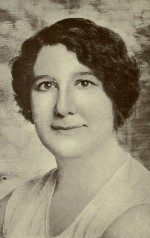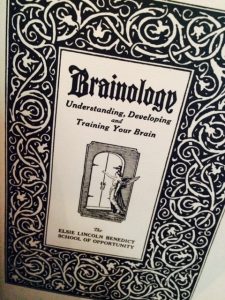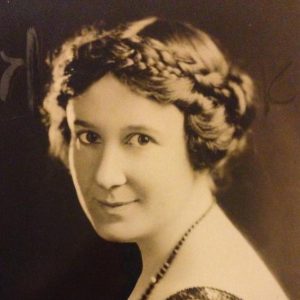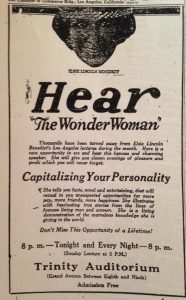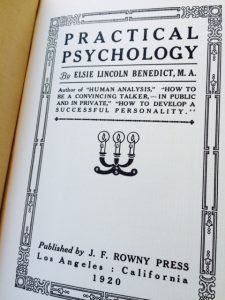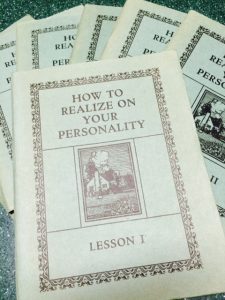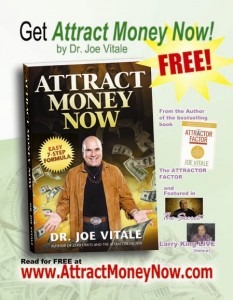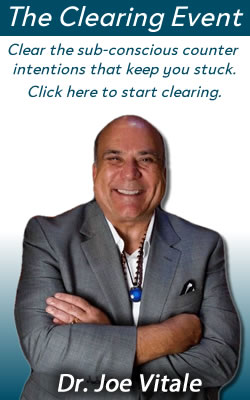Tag: brainology
Forgotten Wonder Woman
Elsie Lincoln Benedict.
Recognize her name?
Neither did I until I found a copy of her 1928 book, Brainology.
Turns out this remarkable woman was the most popular self-help author in the world in the 1920s – seen by over three million people during her lifetime – before radio, television, and of the course the Internet.
The only person maybe more well known as a speaker was the former athlete turned fiery evangelist Billy Sunday. (I’ll pause while you Google him.) But even his extreme popularity shrunk in the 1920s as Else’s grew.
Elsie was an American suffragist leader, international lecturer, and popular author on psychology, self-improvement, and more.
She created and ran the Benedict School of Opportunity and founded The International Opportunity League, a book and correspondence business.
She traveled the world with her husband, Ralph Benedict, visiting at least 55 countries, and wrote about their adventures in a popular book, Our Trip Around the World.
She was born in 1885.
She was a millionaire by 1920.
This amazing woman wrote numerous books, such as Practical Psychology (1920), and with her husband, Unlocking the Subconscious (1922), How to Make More Money (1925), and their standout bestseller, How to Analyze People on Sight (1921).
I found Brainology: Understanding, Developing and Training Your Brain, and couldn’t believe it was written in 1928 but as useful today as it was when it first came out. She was way ahead of the modern fields of positive psychology and neuroscience.
Who was Elsie?
Apparently she was a cutting-edge leader, a petite woman with a commanding presence and charming personality, speaking and writing on what Napoleon Hill and Dale Carnegie and a long list of men would do later.
In many ways, while Elsie was just as upbeat as Hill or Carnegie, and just as subtly metaphysical, she was more practical. She gave people the nuts and bolts of how to succeed by teaching them practical psychology.
Hers was a common sense approach to a happy, healthy, prosperous life.
And she championed women’s rights.
She spoke — in the 1920s, remember — on such topics as Sex Psychology, How to Choose a Mate, How to Get Anything You Want, How to Succeed in Business, and more.
In 1922 she told an audience, “Most people use less brains in selecting the person with whom they are to spend their lives than they do in choosing an automobile, a bicycle or a cut of steak. Love isn’t enough; there must also be understanding.”
She made money even during the Great Depression. Her talks (usually free) inspired people. She urged them to think right, take action and take care of themselves. She also wrote, Outwitting the Depression.
She believed in the “work cure,” which was a new way to handle nervousness and hysteria and other psychological problems of the early 1920s.
The idea was to get you to do useful activities, like taking a college class, learning carpentry or music, or running an office.
The “cure” for what ails you was in the “work,” or the doing, of something meaningful.
Instead of disconnecting from life, you re-connected to life.
In 1923, the Oakland Tribune called Elsie “Wonder Woman,” explaining that “..she actually MAKES OVER THE LIVES of those who follow her wonderful, powerful teachings.”
When Elsie was asked, in 1920, how she attracted 3,000 people at a time to her talks, with hundreds being turned away due to lack of room, she replied, “Because I talk on the one subject on earth in which every individual is most interested – himself.”
I got so excited discovering Else that I went looking for more of her books. I found a pristine 1920 edition of Practical Psychology.
What a treat!
I was impressed at how her clear, direct, conversational writing style communicated practical insights about everything from how to stop worrying, how to build self-confidence, to how to make money.
I of course jumped to the How to Make Money chapter, which was the last one in the book.
Knowing all her readers would do what I did, there’s a line in parenthesis in that chapter where she says, “You are reading this chapter first!”
Elsie knew people.
While I haven’t seen her use the phrase “Law of Attraction” – yet, as I haven’t read all of her books yet – she certainly knew the power of the mind to direct action, which attracted results.
In that last chapter in Practical Psychology she writes:
“All men and women who have climbed to the top of life’s ladder climbed up mentally first.”
When her husband died in 1941, Elsie withdrew from public life.
She was heart broken.
She stayed plugged into life by traveling and visiting family.
But her public appearances and books were over.
She died in 1970.
I’m glad I discovered her.
She was one of those pioneers who paved the way for many others, including me and other Law of Attraction authors, by stepping forth in courage to share her message of self-help and self-improvement.
“Make a rule to dwell on nothing but the strong and good in life and people.”- Elsie and Ralph Benedict, Brainology, 1928
Thank you, Elsie.
I love you.
Ao Akua,
Joe
PS — Heather Mickelson, Else’s great granddaughter, is bringing the “forgotten wonder woman” back into public awareness by reissuing her lost books, writing a biography, and carrying her work into the modern age with humanitarian efforts. Heather’s site explains it all. See http://www.elsielincolnbenedict.com/

